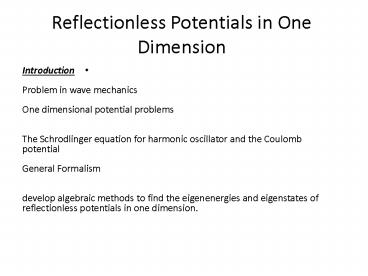Reflectionless Potentials in One Dimension PowerPoint PPT Presentation
Title: Reflectionless Potentials in One Dimension
1
Reflectionless Potentials in One Dimension
- Introduction Problem in wave mechanics One
dimensional potential problems The
Schrodlinger equation for harmonic oscillator and
the Coulomb potential General
Formalism develop algebraic methods to find
the eigenenergies and eigenstates of
reflectionless potentials in one dimension.
2
- Discussion and results
- The transmission coefficient, Tl(k), has a pole
at every value of k at which the potential l(l
1) sech2 x has a bound state. - - For l 1 ? a pole at k i.
- - For l 2 ? poles at k i and k 2i.
3
- In addition to the bound states at k i, 2i, 3i,
... , the potential l(l 1) sech2 x has a bound
state at zero energy. The solution to the
Schrodinger equation at - k2 0 must become asymptotic to a straight line,
?l(0, x) ? A Bx as x ? 8. When the slope (B)
of the straight line vanishes, the system is said
to possess a bound state at zero energy. The name
is justified by the fact that making the
potential infinitesimally deeper (and the problem
no longer exactly solvable) gives a state bound
by an infinitesimal binding energy. Bound states
at zero energy are very special to reflectionless
potentials.
4
- If we parameterize Tl (k) in terms of a phase
shift, Tl (k) exp (2idl (k )), then it is easy
to show that the difference between the phase
shift at k 0 and k ? 8 counts ? times the
number of bound states, with the bound state at
zero energy counting as ½. This result, known as
Levinson's theorem, holds for arbitrary
potentials in three dimensions as well as one
dimension.
5
- Summary
- Reflectionless potential form a simple and
versatile laboratory for studying the properties
of bound states and scattering. - References
- Introductory Quantum Mechanics, Liboff.
- Methods of Mathematical Physics, Morse and
Feshbach.
PowerShow.com is a leading presentation sharing website. It has millions of presentations already uploaded and available with 1,000s more being uploaded by its users every day. Whatever your area of interest, here you’ll be able to find and view presentations you’ll love and possibly download. And, best of all, it is completely free and easy to use.
You might even have a presentation you’d like to share with others. If so, just upload it to PowerShow.com. We’ll convert it to an HTML5 slideshow that includes all the media types you’ve already added: audio, video, music, pictures, animations and transition effects. Then you can share it with your target audience as well as PowerShow.com’s millions of monthly visitors. And, again, it’s all free.
About the Developers
PowerShow.com is brought to you by CrystalGraphics, the award-winning developer and market-leading publisher of rich-media enhancement products for presentations. Our product offerings include millions of PowerPoint templates, diagrams, animated 3D characters and more.

